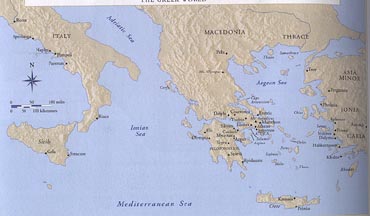Art Home | ARTH Courses | ARTH 209 Home
ARTH 209
History of Greek and Roman Art
Fall, 2013
Assignments
September 3 : Introductory Class
September 10: Review images of Minoan and Mycenaean Art. Read Pedley, 45-101.
September 17: Geometric and Orientalizing Periods. Read Pedley, 103-145. Review images on pages dedicated to Geometric Vase Painting, Geometric Architecture, and Geometric Sculpture. In considering the vases, try to articulate evidence for the development of the vases. For the Orientalizing period, consider the pages dedicated to Vase Painting, Architecture, Greek Orders and Parts of the Temple, and Sculpture. Read the excerpt from Homer's Odyssey and use it to try to articulate attitudes during the Orientalizing period.
In studying the development of Greek Architecture we will be focusing primarily on temple architecture. It is important that we have a sense of the nature of Greek Religion. See the excerpts included on the webpage dedicated to Greek Religion.
Just as we can gain an understanding of the Greek mentality through a study of their religious experience, we also gain an understanding through their language. Key Greek ideas can be gained through understanding the cultural meaning of words like agon. See the webpage entitled Greek Words for a preliminary glossary of significant words in Greek culture.
September 24: Pedley, pp. 147-189. Archaic Art I: we will examine the creation of monumental stone sculpture in the form of the nude, standing male figure, the Kouros (pl. kouroi) and the female counterpart, the kore figure. Review webpages entitled Archaic Sculpture, and Archaic Sculpture II: Kore. Time permitting we will turn to Archaic Architecture.
October 1: Read Pedley, pp. 189-205: Archaic Art II: a principal focus of the class will be the development of Archaic Greek Vase Painting.
October 8: Read Pedley, pp. 207-247: Early Classical Art: the focus of the class will be on the radical transformation of the human figure in Early Classical Art.
October 15: First Seminar: The Parthenon. Details of the seminar are explained on a page entitled Mid-Term Project: The Parthenon.
October 22: We will continue the seminar on the Parthenon, picking up with the architectural sculpture. We will return to the Doryphoros of Polykleitos, and then go on to look at later fifth century monuments in Athens with an emphasis on the Erechtheum. Gallery of Images
October 29: Late Classical of the Fourth Century. Review webpages dedicated to the Late Classical and the Aphrodite of Knidos. Pedley, pp. 289-337.
November 5: Consider the material included on the page dedicated to Hellenistic Art and read Pedley, pp.339-385.
November 12: read the chapter on Roman Republican art in Ramage and Ramage, pp. 69-109. Look at the images and read the texts included on the webpage dedicated to Roman Republican portraiture.
November 19: Second Seminar: Art and Architecture of the Age of Augustus. Ramage and Ramage, 5th edition, pp. 111-143 (Chapter 3: Augustus and the Imperial Idea).
December 3: Roman Architecture. See also the webpage entitled Roman Architecture/Roman Power. Review sections on architecture in the various chapters of Ramage and Ramage: pp. 61-73; 101-110; 150-155; 157-162; 193-198; 213-231 (note that these readings might be off. They might have been done to an earlier edition of Ramage and Ramage. Unfortunately I am in D.C. and can't check it until Monday.)
December 10: for an introduction to Roman Imperial iconography see the page dedicated to the Panels of Marcus Aurelius. For more images see web page for my ARTH 109 class: Roman Imperial Sculpture. See also Column of Trajan and Comparisons.
Highly recommended website: Ancient-Greece.org. This site is the work of Thomás Sakoulas.
Art Home | ARTH Courses | ARTH 209 Home
(archived)
